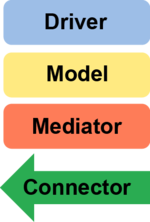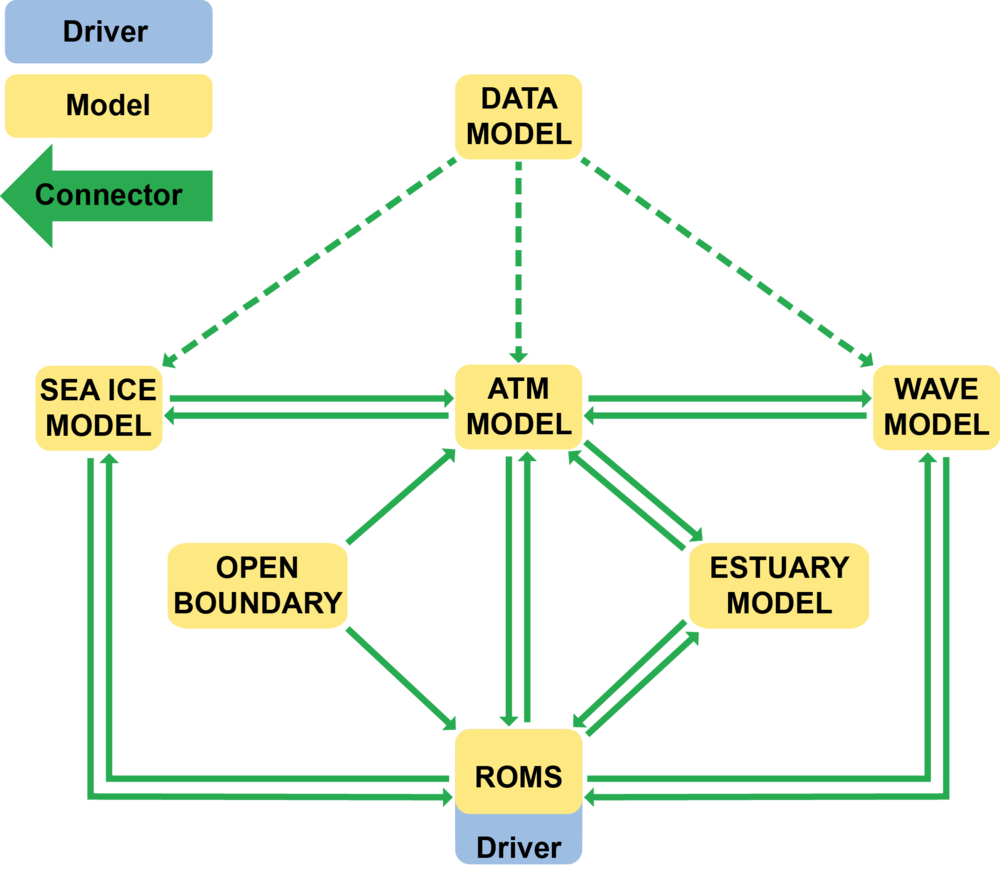Difference between revisions of "Model Coupling ESMF"
| Line 1: | Line 1: | ||
= | <div class="title">EARTH SYSTEM MODEL FRAMEWORK (ESMF)</div>__NOTOC__ | ||
<!-- Edit Template:Model_Coupling_TOC to modify this Table of Contents--> | |||
<div style="float: left;margin: 0 20px 0 0;">{{Model Coupling TOC}}</div>__TOC__ | |||
<div style="clear: both"></div> | |||
==Overview== | |||
Significant progress has been made over the past decade in the standardization of coupling tools without reducing model diversity through the Earth System Modeling Framework (ESMF; Collins et al., 2005) and the National Unified Operational Prediction Capability (NUOPC) consortia. The NUOPC layer on top of ESMF is an agreement between the Department of Commerce (NOAA) and the Department of Defense (Navy, Air Force) to standardize the coupling between Earth System Models (ESM) components under a common framework. | Significant progress has been made over the past decade in the standardization of coupling tools without reducing model diversity through the Earth System Modeling Framework (ESMF; Collins et al., 2005) and the National Unified Operational Prediction Capability (NUOPC) consortia. The NUOPC layer on top of ESMF is an agreement between the Department of Commerce (NOAA) and the Department of Defense (Navy, Air Force) to standardize the coupling between Earth System Models (ESM) components under a common framework. | ||
The NUOPC Layer is a simplified infrastructure on top of the ESMF library (version 7 or higher) that provides conventions and templates to facilitate the smooth coupling between ESM components. | The NUOPC Layer is a simplified infrastructure on top of the ESMF library (version 7 or higher) that provides conventions and templates to facilitate the smooth coupling between ESM components. | ||
[[File:ESMF-NUOPC_Components.png|150px]] | |||
'''''Figure 1:''''' NUOPC layer generic components | |||
The ROMS coupling interface with the ESMF/NUOPC library allows both driver and component methods of operation. In the driver method, it provides all the interfaces needed to couple to other ESM components including the executable driver, NUOPC-based generic ESM component services, model gridded components or NUOPC Model cap files, connectors between components for re-gridding source and destination fields, input scripts, and coupling metadata management. A NUOPC Model cap is a Fortran code layer that sits on top of the ESM component, making calls to the numerical kernel via the initialize, run, and finalize phases. Alternatively, in the component method, the NUOPC ROMS cap module is provided, and it can be adapted and incorporated into other NUOPC-based coupling systems, like the NOAA Environmental Modeling System (NEMS). | |||
[[File:ROMS_Coupling_Framework_Driver_Mode.png|1000px]] | |||
'''''Figure 2:''''' ROMS driver mode ESMF/NUOPC coupling framework | |||
A prototype of the ROMS coupling framework based on the ESMF/NUOPC library is illustrated in Figure | A prototype of the ROMS coupling framework based on the ESMF/NUOPC library is illustrated in Figure 2 showing the Driver, Models, and Connectors. The Driver controls all the aspects of the coupling between the ESM components and their connections: configuration, initialization, time-stepping sequence, data exchanges, and termination. The Models are the gridded data and gridded geophysical numerical kernels wrapped into a NUOPC cap file interface. The Connectors between ESM components execute the remapping and regridding between the source and destination fields. The interpolation is usually linear with extrapolation support in the vicinity of masked grid cells. In this project, the coupling framework will include the Atmosphere Model (WRF), the Ocean Model (ROMS), and the Data Model since the grids are incongruent. The Data Model is needed because WRF requires sea surface temperature (SST) on those grid points not covered by ROMS (see Figure X). | ||
Revision as of 19:42, 21 February 2019
Overview
Significant progress has been made over the past decade in the standardization of coupling tools without reducing model diversity through the Earth System Modeling Framework (ESMF; Collins et al., 2005) and the National Unified Operational Prediction Capability (NUOPC) consortia. The NUOPC layer on top of ESMF is an agreement between the Department of Commerce (NOAA) and the Department of Defense (Navy, Air Force) to standardize the coupling between Earth System Models (ESM) components under a common framework.
The NUOPC Layer is a simplified infrastructure on top of the ESMF library (version 7 or higher) that provides conventions and templates to facilitate the smooth coupling between ESM components.
Figure 1: NUOPC layer generic components
The ROMS coupling interface with the ESMF/NUOPC library allows both driver and component methods of operation. In the driver method, it provides all the interfaces needed to couple to other ESM components including the executable driver, NUOPC-based generic ESM component services, model gridded components or NUOPC Model cap files, connectors between components for re-gridding source and destination fields, input scripts, and coupling metadata management. A NUOPC Model cap is a Fortran code layer that sits on top of the ESM component, making calls to the numerical kernel via the initialize, run, and finalize phases. Alternatively, in the component method, the NUOPC ROMS cap module is provided, and it can be adapted and incorporated into other NUOPC-based coupling systems, like the NOAA Environmental Modeling System (NEMS).
Figure 2: ROMS driver mode ESMF/NUOPC coupling framework
A prototype of the ROMS coupling framework based on the ESMF/NUOPC library is illustrated in Figure 2 showing the Driver, Models, and Connectors. The Driver controls all the aspects of the coupling between the ESM components and their connections: configuration, initialization, time-stepping sequence, data exchanges, and termination. The Models are the gridded data and gridded geophysical numerical kernels wrapped into a NUOPC cap file interface. The Connectors between ESM components execute the remapping and regridding between the source and destination fields. The interpolation is usually linear with extrapolation support in the vicinity of masked grid cells. In this project, the coupling framework will include the Atmosphere Model (WRF), the Ocean Model (ROMS), and the Data Model since the grids are incongruent. The Data Model is needed because WRF requires sea surface temperature (SST) on those grid points not covered by ROMS (see Figure X).

